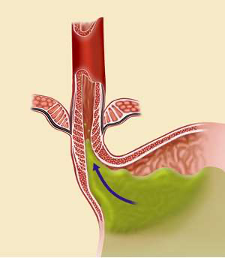
What is GERD?
Reflux (GERD) is caused by a weak muscle in your esophagus called the Lower Esophageal Sphincter (LES). The LES is your body’s reflux barrier that acts as a one-way valve to allow food and liquid to pass into the stomach but prevents stomach contents from coming back into the esophagus.
Why am I having GERD and Heartburn?
-
The exact cause isn’t always obvious however multiple conditions can cause an increase of acid in your stomach - Obesity, Hiatal hernia, Smoking, Trigger foods.
What is the difference between GERD and Heartburn?
-
Gastroesophageal reflux is a disease that is caused by acid that is produced in your stomach that goes up into the esophagus.
-
Heartburn is a symptom of GERD-which can cause pain after eating or lying down.
THE LONG-TERM EFFECTS OF GERD
Stomach acid plays an important role to break down food that your body can absorb. When acid leaves your stomach and refluxes into your esophagus, you can experience belching, gas, nausea, a dry cough, regurgitation, and a bitter taste in your mouth.
This repeated acid reflux can damage your esophagus, throat and lungs causing painful symptoms like heartburn, hoarseness, difficulty swallowing, sore throat, cough and tooth decay. This may lead to some serious complications, including esophageal cancer.
HOW DO I KNOW IF I HAVE GERD?
It is important to have the appropriate testing to diagnose GERD to determine what treatment options can help.
Marshmallow Bagel Esophagram – This test is done to evaluate the esophagus muscle movement. The patient is given a barium-soaked bite of a marshmallow and barium-soaked bite of a bagel to swallow as x-rays are taken to follow its movement through the gastroesophageal junction.
-
Endoscopy: also called EGD, this procedure allows the doctor to view the lining for the esophagus and stomach. The patient is typically sedated in order for a camera inside a small tube to be inserted into the mouth and through the esophagus. Using the camera, the doctor will look for causes of reflux symptoms like inflammation, hernias, or ulcers. In more extreme cases, the EGD can show complications of GERD, like esophagitis and Barrett’s esophagus.
-
Biopsy: a biopsy for diagnosing GERD uses a sample of tissue removed from the lining of the esophagus and then tested by a pathology lab. The biopsy shows if there is a more serious complication of GERD like cancer, ulcers or infection. A biopsy can be performed in conjunction with an EGD depending on the findings of the EGD.
-
Esophageal Manometry: This test checks to make sure the esophagus is functioning normally. The procedure uses a small and flexible tube passed through the nose and into the esophagus and stomach to examine the functionality of the esophageal sphincter, a valve located in between the stomach and esophagus. The health of the esophagus is tested by sensors on the tube monitor pressure exerted throughout the esophagus and stomach.
-
pH Monitoring: pH monitoring records levels of esophageal acidity over one or two days. Using a pH sensor placed on the esophagus, by tube or suction, the patient also uses a device to record heartburn (acid reflux) symptoms and keep a food and drinks diary during the testing period. The doctor will use the results of the pH device and compare it to the food diary to monitor intensity and patterns of the patient’s reflux symptoms.
